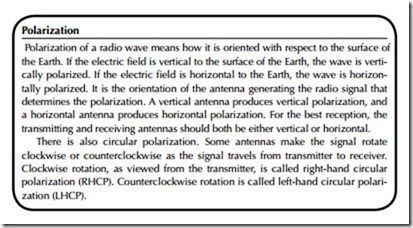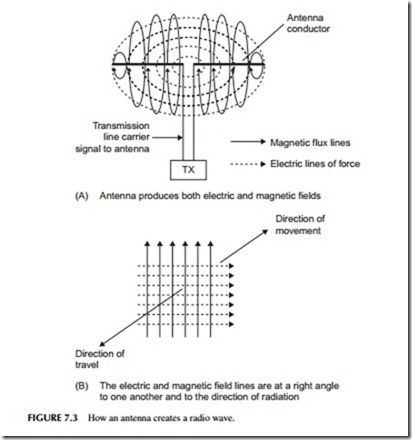WHAT IS A RADIO WAVE ANYWAY?
Any discussion of radio always gets around to this basic question. How do you describe something that you cannot see, feel, or hear? You imagine it.
Electric and Magnetic Fields
A radio wave is an invisible force field that is made up of both a magnetic field and an electric field. In combination, we call them an electromagnetic field. We can’t see or feel them, but we can experience their effects. In Chapter 2, electric and magnetic fields are described briefly. To review, a magnetic field is a force generated by a magnet, either a permanent magnet or electromagnet. Current flow in a wire or other conductor produces the magnetic field. Invisible magnetic flux lines emanate from the magnet and may influence objects in or near them.
An electric field derives from a voltage, or what we call a potential, across two conductors. The attraction of the positive and negative charges across an open space introduces another kind of invisible field that can also influence external objects.
Now if you combine these two types of fields into a self-supporting entity, you would have an electromagnetic field or radio wave. We create a radio signal with the circuits in a transmitter, but it is the magic of a device called an antennathat produces the combined electric and magnetic field that we refer to as a radio wave.
In the 19th century, a British scientist named James Clerk Maxwell figured out that if you generate a changing electric field, it would, in turn, generate a magnetic field. If the magnetic field is changing and moving forward, it will generate an electric field. The two fields support or regenerate one another as they change and move outward from the antenna that produces them. Maxwell expressed his theories in his famous mathematical equations that form the foundation of radio and light transmission.
Trying to draw a picture of a radio wave is somewhat like trying to draw a picture of the wind. Nevertheless, Figure 7.3A is an attempt. Try to think in three dimensions. Current flow in the antenna wire creates the magnetic field lines. The voltage across the two segments of the antenna produces the electric field lines. The picture is somewhat simplified if we just show the field lines as in Figure 7.3B. The electric and magnetic field lines are always at right angles (90 degrees) to one another. The radio wave moves in a direction at a right angle to both field lines, in this case either into or out of the page. As it gets some distance from the antenna, it becomes self-supporting. That is, the magnetic field sustains the generation of the electric field and vice versa.
Signal Speed
Radio waves travel at the speed of light in space. That is 300,000,000 meters per second or 186,410 miles per second. So while radio transmission is not
instantaneous, it is pretty fast. Just as an example, to transmit a signal to the moon that is 250,000 miles away takes 250,000/186,400 = 1.34 seconds.
Signal Strength
As the radio wave gets farther and farther from the antenna, it gets weaker and weaker. The power in a radio wave, in fact, decreases by the square of the distance from the antenna. For example, doubling the distance decreases the received power by two squared (22 ) or four. Even when the transmitter puts many hundreds or thousands of watts of power into the antenna, the signal received at a distance is many times smaller. Typical radio signals are usually expressed in terms of microwatts (1-millionth of a watt) or nanowatts (1-billionth of a watt).
As the radio wave encounters a receiving antenna, the magnetic and elec- tric fields induce a voltage into the antenna. This tiny voltage is then amplified and translated back into the original information signal by the receiver.

